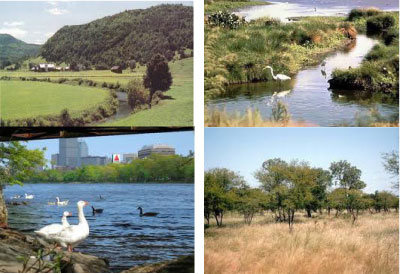
Hello and welcome to another edition of the environment, your weekly column that brings environmental issues to the lime light.
In our today’s edition we looked at the some of the effects of habitat and its relations to conservation and other environmental issues.
Habitat conservation is vital for protecting species and ecological processes. It is important to conserve and protect the space/area in which that species occupies. Therefore, areas classified as ‘biodiversity hotspots’, or those in which a flagship, umbrella, or endangered species inhabits are often the habitats that are given precedence over others.
Species that possess an elevated risk of extinction are given the highest priority and as a result of conserving their habitat, other species in that community are protected thus serving as an element of gap analysis.
Habitat conservation
Habitat conservation is a land management practice that seeks to conserve, protect and restore habitat areas for wild plants and animals, especially conservation reliant species, and prevent their extinction, fragmentation or reduction in range. It is a priority of many groups that cannot be easily characterized in terms of any one ideology.
Values of natural habitat
The natural environment is a source for a wide range of resources that can be exploited for economic profit, for example timber is harvested from forests and clean water is obtained from natural streams. However, land development from anthropogenic economic growth often causes a decline in the ecological integrity of nearby natural habitat.
However, there is also economic value in conserving natural habitat. Financial profit can be made from tourist revenue, particularly in the tropics where species diversity is high. The cost of repairing damaged ecosystems is considered to be much higher than the cost of conserving natural ecosystems.
Measuring the worth of conserving different habitat areas is often criticized as being too utilitarian from a philosophical point of view.
Biodiversity
Habitat conservation is important in maintaining biodiversity, an essential part of global food security. There is evidence to support a trend of accelerating erosion of the genetic resources of agricultural plants and animals. An increase in genetic similarity of agricultural plants and animals means an increased risk of food loss from major epidemics. Wild species of agricultural plants have been found to be more resistant to disease, for example the wild corn species Teosinte is resistant to 4 corn diseases that affect human grown crops. A combination of seed banking and habitat conservation has been proposed to maintain plant diversity for food security purposes.
Natural causes
Habitat loss and destruction can occur both naturally and through anthropogenic causes. Events leading to natural habitat loss include climate change, catastrophic events such as volcanic explosions and through the interactions of invasive and non-invasive species. Natural climate change, events have previously been the cause of many widespread and large scale losses in habitat.
Previously known warm areas in the tropics, the most sensitive habitats on Earth, grew colder, and areas such as Australia developed radically different flora and fauna to those seen today. The big five mass extinction events have also been linked to sea level changes, indicating that large scale marine species loss was strongly influenced by loss in marine habitats, particularly shelf habitats. Methane-driven oceanic eruptions have also been shown to have caused smaller mass extinction events.
Human impacts
Since radiating out from its birthplace in Africa, Homo sapiens has been the cause of many species’ extinction. Due to humans’ propensity to shape and modify their environment, the habitat of other species often become altered or destroyed as a result of human actions. Even before the modern industrial era, humans were having widespread, catastrophic effects on the environment.
Aboriginal hunting
Aboriginal hunting practices, which included burning large sections of forest at a time, eventually altered and changed Australia’s vegetation so much that many herbivorous mega fauna species were left with no habitat and were driven into extinction. Once herbivorous mega fauna species became extinct, carnivorous mega fauna species soon followed. In the recent past, humans have been responsible for causing more extinction within a given period of time than ever before.
Deforestation, pollution, anthropogenic climate change and human settlements have all been driving forces in altering or destroying habitats. The destruction of ecosystems such as rainforests has resulted in countless habitats being destroyed. These biodiversity hotspots are home to millions of habitat specialists, which do not exist beyond a tiny area. Once their habitat is destroyed, they cease to exist.
Current and future climatologically effects of human influences
Climate change is a significant and lasting change in the statistical distribution of weather patterns over periods ranging from decades to millions of years. It may be a change in average weather conditions, or in the distribution of weather around the average conditions (i.e., more or fewer extreme weather events).
Climate change is caused by factors that include oceanic processes (such as oceanic circulation), variations in solar radiation received by Earth, plate tectonics and volcanic eruptions, and human-induced alterations of the natural world; these latter effects are currently causing global warming, and “climate change” is often used to describe human-specific impacts.
Scientists actively work to understand past and future climate by using observations and theoretical models. Borehole temperature profiles, ice cores, floral and faunal records, glacial and peri-glacial processes, stable isotope and other sediment analyses, and sea level records serve to provide a climate record that spans the geologic past.
More recent data are provided by the instrumental record. Physically based general circulation models are often used in theoretical approaches to match past climate data, make future projections, and link causes and effects in climate change.
Conservation movement
For much of human history, nature had been seen as a resource, one that could be controlled and used for personal and economic gain. The idea was that plants only existed to feed animals and animals only existed to feed man. The land itself had limited value only extending to the resources it could provide such as minerals and oil. Throughout the 18th and 19th centuries social views started to change and when in 1872, the world’s first national park, Yellowstone National Park in the United States of America, was declared, did the official conservation movement begin?
Rather than focusing on the economic or material benefits associated with nature, humans began to appreciate the value in the nature itself and the need to protect pristine wilderness. By the middle of the 20th century countries such as the United States, Canada, and Britain understood this appreciation and instigated laws and legislation in order to ensure that the most fragile and beautiful environments would be protected for generations to come.
Today with the coming of NGO’s, not-for profit organizations and governments world-wide there is a stronger movement taking place, with a deeper understanding of habitat conservation with the aim of protecting delicate habitats and preserving biodiversity on a global scale.
The commitment and actions of small volunteering association in villages and towns, that endeavor to emulate the work done by well known Conservation Organizations, is paramount in ensuring generations that follow understand the importance of conserving natural resources. A journalist’s conservation organization with the mission statement “Advocating for sustainable use of natural resources for prosperity in The Gambia.” may one day inspire local people becomes protectors and conservators in their own community.
For your comments, suggestions, contributions please contact (00220) 6361340 or 7142236 or
Email: bajgambia2011@gmail.com
Read Other Articles In Article (Archive)




